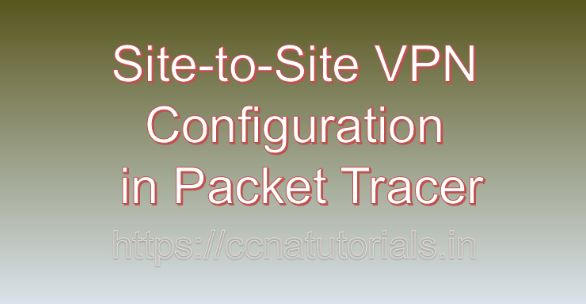Contents of this article
In this article, I describe the process of Site-to-Site VPN Configuration in Packet Tracer. In today’s interconnected world, securing network communication is paramount. As businesses expand globally and remote work becomes more prevalent, establishing secure connections between different sites is crucial. This is where Virtual Private Networks (VPNs) come into play, enabling secure communication over public networks like the internet. Site-to-Site VPNs, in particular, facilitate secure communication between multiple sites of an organization.
In this comprehensive guide, we’ll delve into the world of configuring Site-to-Site VPNs using Packet Tracer, a powerful network simulation tool widely used for educational and training purposes. Whether you’re a networking enthusiast, a student, or a professional seeking to enhance your skills, understanding how to configure Site-to-Site VPNs in Packet Tracer can be immensely beneficial.
Understanding Site-to-Site VPNs
Before diving into configuration, it’s essential to grasp the concept of Site-to-Site VPN Configuration in Packet Tracer. Unlike Remote Access VPNs, which allow individual users to connect securely to a network from a remote location, Site-to-Site VPNs establish secure connections between entire networks or sites. This enables seamless communication between geographically dispersed offices, branches, or data centers.
Site-to-Site VPNs typically utilize IPsec (Internet Protocol Security) protocols to encrypt and authenticate data traffic traversing the VPN tunnel. This ensures confidentiality, integrity, and authenticity of the transmitted data, making it secure against eavesdropping and tampering.
Packet Tracer: An Overview
Packet Tracer, developed by Cisco Systems, is a network simulation tool used for teaching and learning purposes. It allows users to design, configure, and troubleshoot network topologies in a virtual environment, mimicking real-world networking scenarios. While Packet Tracer may not support every feature of actual Cisco devices, it provides a robust platform for learning and practicing networking concepts, including VPN configurations.
Configuring Site-to-Site VPNs in Packet Tracer
Let’s walk through the steps of configuring a Site-to-Site VPN in Packet Tracer. For the sake of illustration, we’ll consider a simple scenario involving two branch offices (Branch A and Branch B) connected over the internet through a secure VPN tunnel.
Step 1: Designing the Network Topology
Start by designing the network topology in Packet Tracer. Place routers representing the branch offices and connect them to the internet cloud symbolizing the public internet. Ensure appropriate addressing schemes are assigned to the interfaces of the routers and that connectivity between them is established.
Step 2: Configuring IKE Phase 1 (Internet Key Exchange)
IKE Phase 1 establishes a secure channel for negotiating parameters of the IPsec tunnel. Configure IKE Phase 1 parameters on both routers, including authentication methods, encryption algorithms, and Diffie-Hellman group settings. Ensure that pre-shared keys or digital certificates are configured for secure authentication between the peers.
Step 3: Configuring IKE Phase 2 (IPsec Security Associations)
IKE Phase 2 negotiates the IPsec Security Associations (SAs) used for encrypting and authenticating data traffic. Configure IKE Phase 2 parameters such as encryption and authentication algorithms, lifetime values, and Perfect Forward Secrecy (PFS) settings. Specify the subnets to be encrypted and transmitted over the VPN tunnel.
Step 4: Setting Up Crypto Maps and Access Control Lists (ACLs)
Crypto maps define the IPsec policies applied to specific traffic flows. Configure crypto maps on both routers, associating them with the appropriate IKE Phase 1 and Phase 2 parameters. Additionally, define Access Control Lists (ACLs) to identify the traffic to be encrypted and transmitted over the VPN tunnel. Ensure that the crypto maps and ACLs match on both ends of the VPN tunnel.
Step 5: Verifying and Testing the VPN Configuration
After configuring the Site-to-Site VPN parameters, it’s crucial to verify the configuration and test the VPN tunnel’s functionality. Use diagnostic tools such as ping and traceroute to ensure connectivity between the branch offices over the VPN tunnel. Monitor VPN status and debug logs to troubleshoot any potential issues that may arise.
Best Practices and Considerations
While configuring Site-to-Site VPNs in Packet Tracer, keep the following best practices and considerations in mind:
- Security: Implement strong authentication methods and encryption algorithms to ensure the confidentiality and integrity of data traffic.
- Redundancy: Consider implementing redundant VPN tunnels or failover mechanisms to ensure continuous connectivity in case of link failures.
- Scalability: Design the VPN architecture with scalability in mind, accommodating potential growth and expansion of the network.
- Performance: Optimize VPN configurations for performance by selecting appropriate encryption algorithms and adjusting MTU sizes.
- Monitoring and Maintenance: Regularly monitor VPN tunnels and perform maintenance tasks such as software updates and security patches to mitigate potential vulnerabilities.
Conclusion for Site-to-Site VPN Configuration in Packet Tracer
Configuring Site-to-Site VPNs is a fundamental skill for network engineers and administrators, enabling secure communication between geographically dispersed sites. By mastering the configuration process in Packet Tracer, individuals can gain valuable hands-on experience in implementing VPN solutions and addressing real-world networking challenges.
Whether for educational purposes, certification preparation, or professional development, the knowledge and skills acquired through practicing Site-to-Site VPN configurations in Packet Tracer are invaluable in today’s networking landscape. I hope you found this article helpful related to Site-to-Site VPN Configuration in Packet Tracer. You may contact us or drop a comment below for any query or suggestions about the contents of this website.






